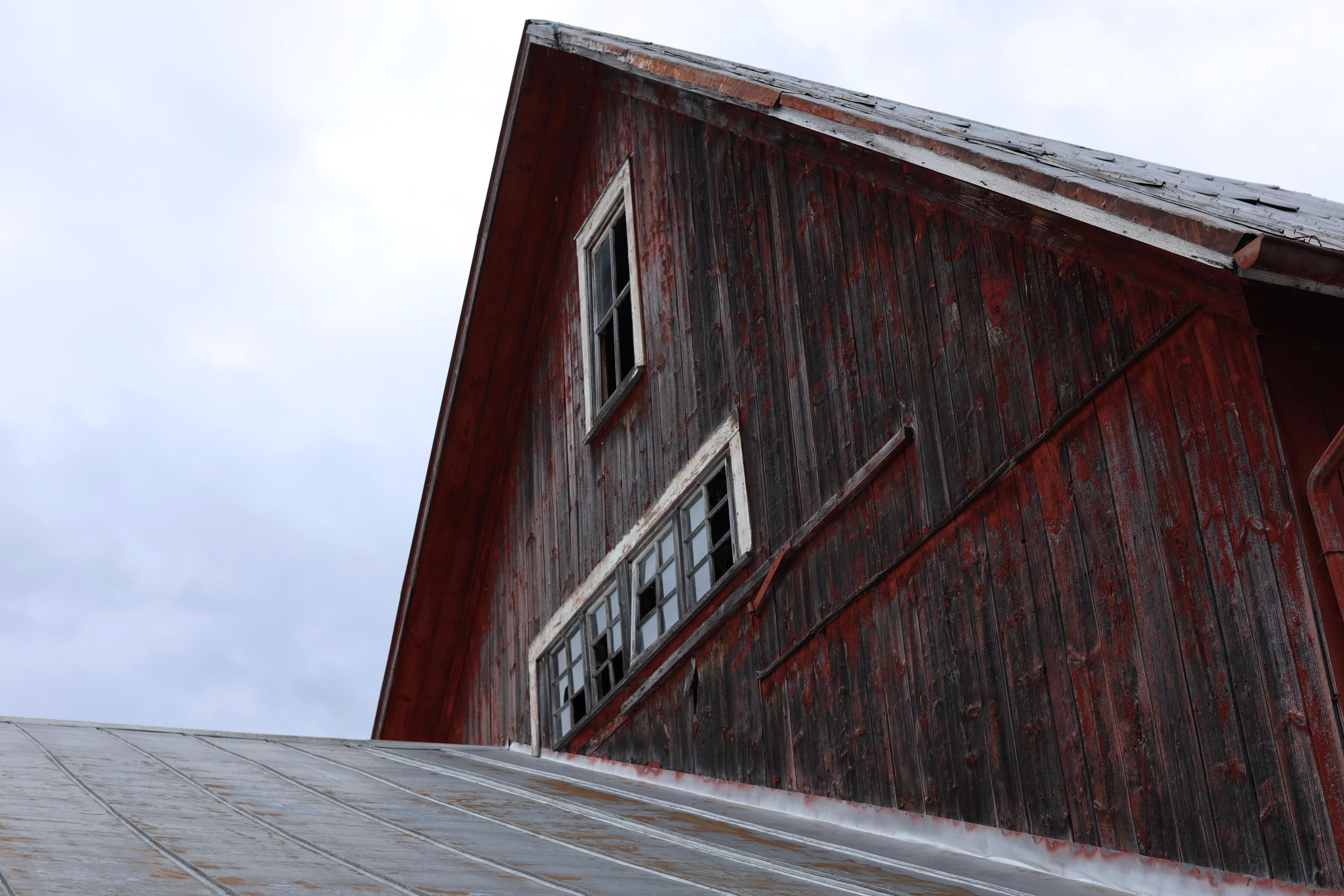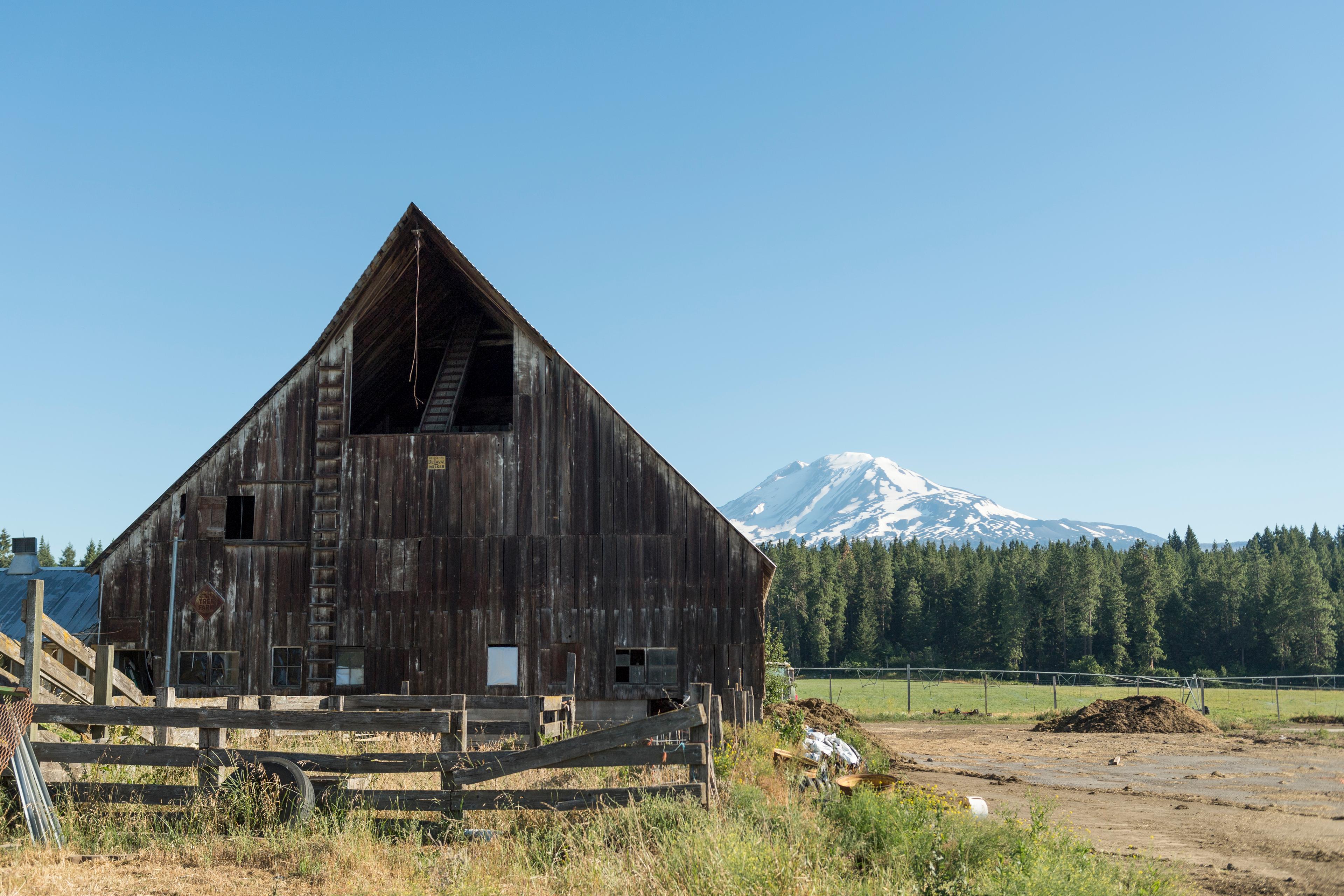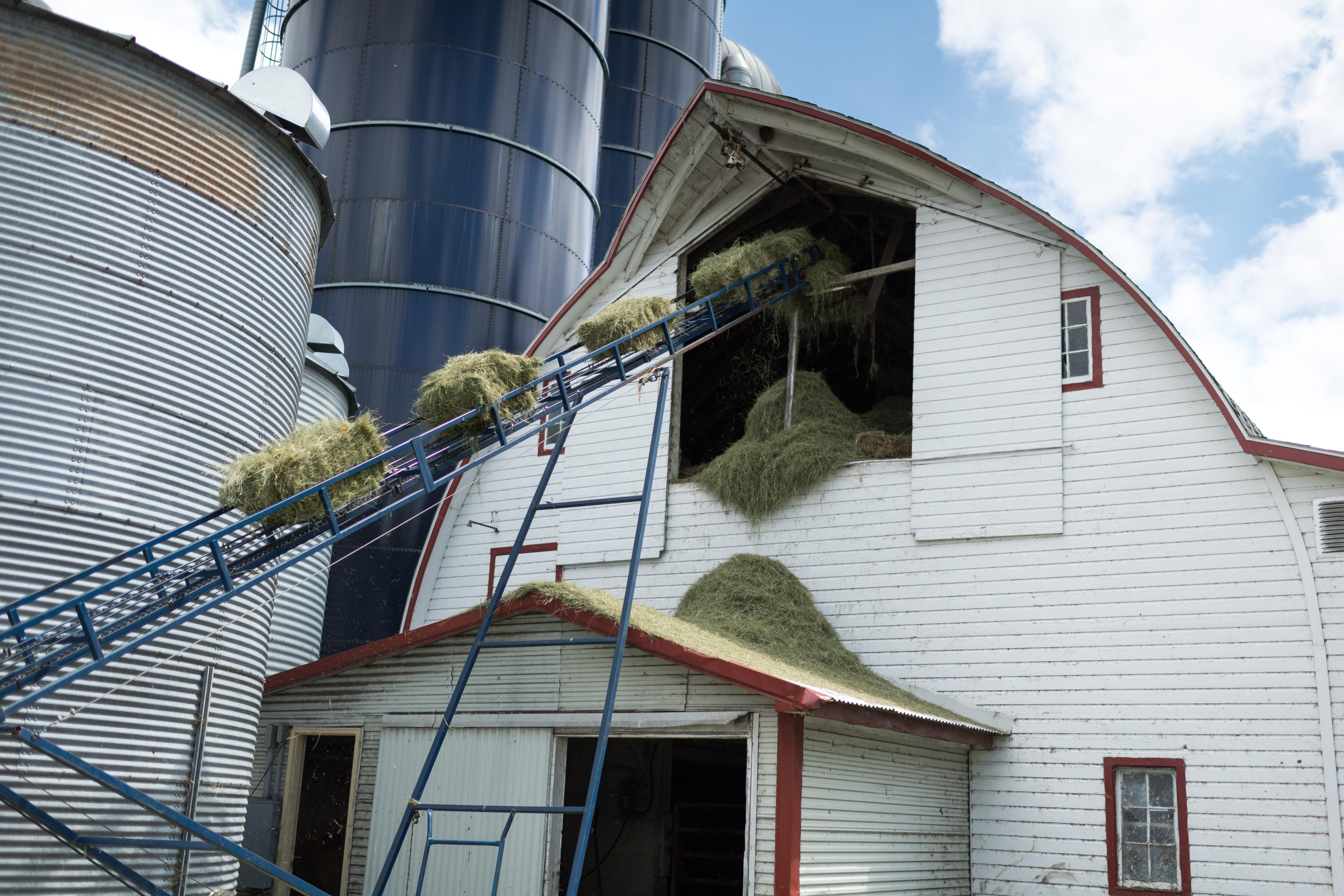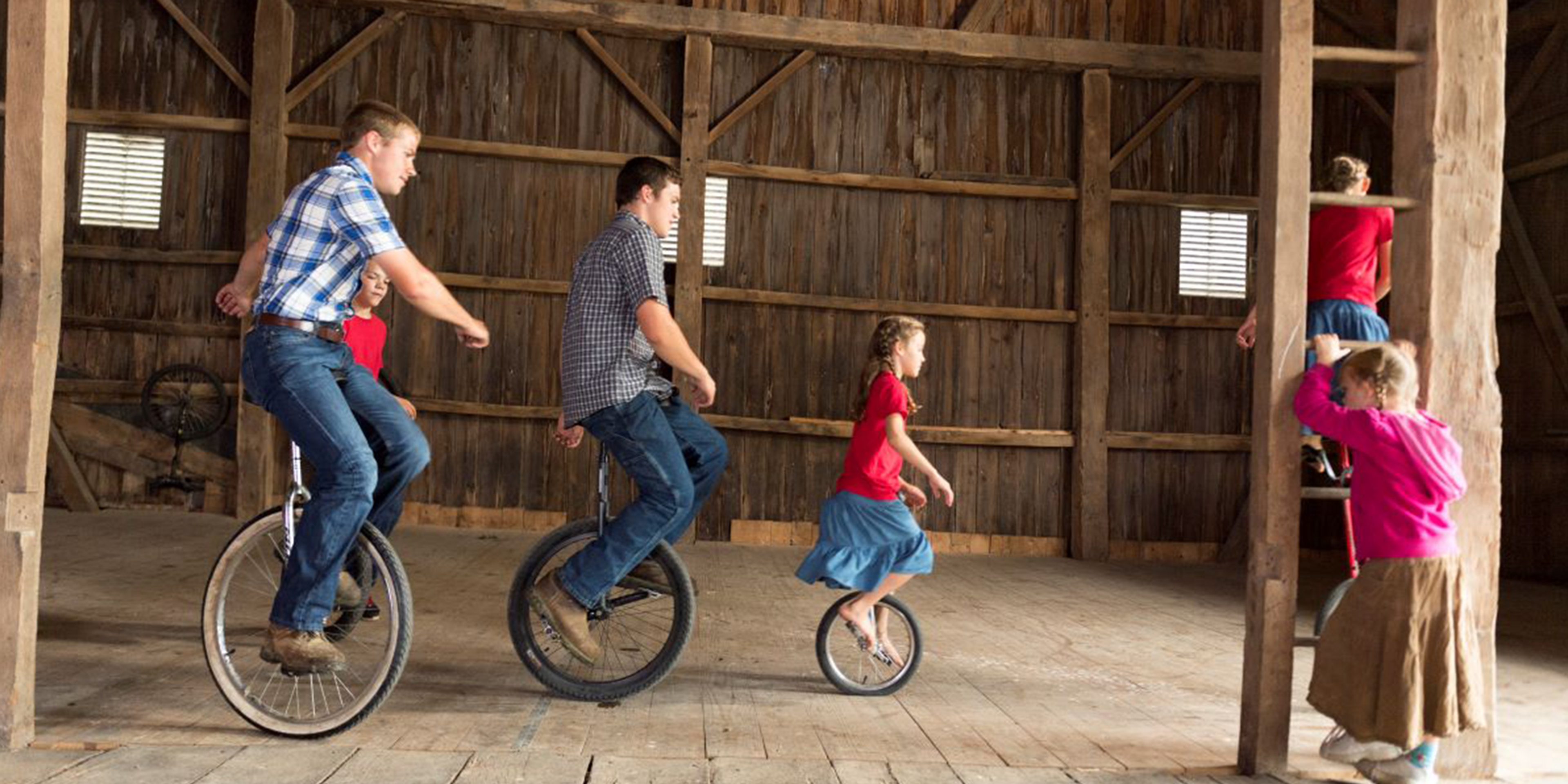
Rooted
The History of Barns and the Changing Farm Landscape
Barns reflect Americans’ relationship with food and rural communities. Throughout history, the buildings have adapted to new farming practices and production, morphing along with people and a way of life. When barns are vacant, they reflect the death of family farms.
A rural renaissance is happening to bring customers back to the land and local markets. But farmers and landowners need support to preserve or maintain barn structures and pivot existing business models to ones that are sustainable well into the future. Tax credits in multiple states where Organic Valley has farms are helping to restore these architectural and cultural gems and the farming lifestyle that accompanies them. Buildings tell a story — the failure, sale and consolidation of farms and their rebirth through barn preservation.
The Beginning of Barns: Pre-1900
Barn tradition came to America with early European settlers. The structural shapes adapted to the landscape and type of farming people needed them for: dairy, tobacco, cattle or hay storage. And while barns adapted to the landscape, they also defined it — becoming the key symbol for rural life that still dominates today. A red barn in Organic Valley’s logo and on the Wisconsin license plate serves as a quintessential icon of the family farm.
Why Are Barns Red?
Here in the United States, a barn is defined as anything that houses livestock, equipment or grain. In the 1700s, people used a varnish containing iron oxide to protect wooden barns, causing them to turn red in sunlight. In the 1800s, chemical-based paints that were red were cheap to buy, so the red barn color continued.
Barns were built for farmers by family members and neighbors, often from the same immigrant community. In Green County, Wisconsin, the landscape looks similar to Switzerland, and many Swiss settled in the area — hence the abundance of Swiss-style cantilever barns. In Stoughton, Wisconsin, Norwegian immigrants built farmsteads with a mixture of tobacco and dairy barns.
“The barns represent the owner and cultural ethnic group that settled there,” said Chuck Law, a retired faculty member and former coordinator of the Wisconsin Barn Preservation Program at the University of Wisconsin-Madison. “In Wisconsin, you see Czech, German, Irish, Polish and Yankee barns. You have this wonderful portfolio of all these different types of barns. And unlike other states, they are painted blue, green, brown and white, in addition to red.”
What Makes a Barn a Barn?
Early in America’s history, barns served as gathering places and grocery stores for neighbors and nearby community members. In addition to selling milk, eggs and produce to neighbors and travelers, the barns housed local dances, serving as a meeting place for generations.
Barn walls served as early billboards for traveling circuses and, eventually, breweries and other companies. The classic American novels “Ethan Frome” by Edith Wharton and “The Witch of Blackbird Pond” by Elizabeth George Speare based in Massachusetts and Connecticut, epitomize farm life and barns as the centerpieces of that life.

The Holstein stock barn is shown on the Howe Farm in Vermont.
Adaptation and Decline: 1900-1980
In the dairy industry, government regulations in the early 20th century required milking to take place on a clean surface: concrete — not wood. Organic Valley farmer Rob Howe says many dairy farms went out of business around this time because they didn’t want to put in a concrete floor. His dad moved milking operations to the ground floor in their traditional basement/bank barn in Vermont.
“Without question, there is a direct correlation between changes in agricultural practice and the construction — the architecture, the style of the barn,” Law said. “It can be traced very easily by looking at how barns have even been modified over time.”
Later, free-stall farming and the advent of milking parlors would again change the layout of barns.
The Great Depression and World War II transformed the trajectory of American farming. Government subsidies set up to protect jobs created a surplus of many crops and lower prices for corn, soybean, dairy, wheat, cotton and rice. The use of synthetic fertilizers like nitrates and pesticides rose with the desire to repurpose wartime factories and byproducts. The farming implement industry grew — persuading farmers that they needed larger equipment to manage their farm fields.
Evolving Equipment and Barns
“When agriculture became more industrialized and larger equipment needed to be housed within a barn, the openings, the access ways, and in some cases the framing was reconstructed to accommodate that machinery. So it’s almost like opening up a history book as you look at these barns and study them. You can understand why a change was made in the early 1900s, 1940s or 1970s.”
Smaller, community-sustained farms gave way to larger, consolidated farming businesses that could scale — managing the high costs of doing business and weathering lower crop prices. These changes meant a decline in small family farms — from 6.4 million in 1910 to 2.2 million in 2000.
Barns were largely left in shambles or used as storage during this period — reflecting the struggle of smaller farms in the ever-industrialized food system. Farms that survived these changes were left with barns that had long outgrown their utility or original intent.
“It’s become an eyesore. They (farmers) still have to pay insurance on it; they have to go out and fix something on it,” Law said regarding farmers’ attitudes toward barns during this time. “As a result, it’s more of a pain in the side. It’s perceived as a liability. Fast forward to where we are today. People understand that those barns have become an asset.”

The Pearson family farm, Washington
Lifeline: 1980 to Today
“When you think about barn preservation, there’s something in it for everybody,” Law said. “Economically, there are the benefits of agritourism and an increase in property value. There’s also sustainability. Repairs can help these well-constructed buildings stand for another century and preserve traditional timber-frame building and construction practices.”
In 2021, Law informally surveyed people looking for rural properties in Wisconsin. They were willing to pay an extra $20,000 to $100,000 for a property with an old barn. Why?
“These old timber-framed structures are designed to last and can be easily retrofitted to accommodate a variety of new uses,” Law said.
Howe wishes farmers would renovate and maintain barns and other outbuildings for their historic value. His ancestral family farm, Holstein Stock Farm, was purchased by the Vermont Land Trust to add solar panels, publicly accessible hiking trails and pastures and barn space for farmers. It’s also home to beef cattle, pigs and sheep.
The farm his grandfather owned, Howe Acres, was one of the top Holstein stock farms in New England. Today, it is photographed religiously and displayed in calendars. Rob’s extended family uses the barn to raise cows and chickens for shows like the World Dairy Expo.
“All those buildings have a story to tell,” he said, adding it’s important to preserve good, rugged barns.
Several states offer incentives for landowners to preserve historic barns, including states with Organic Valley farms: Wisconsin, Vermont, New York and Michigan.
The amount an individual can receive for maintaining or restoring a barn varies by state. In 2022, New York started offering a historic barn preservation tax credit of 25% of qualified expenses — retroactively back to 2017.
In Michigan, barn owners can qualify for a 20% federal tax credit. For owners to qualify, the barn must be on the National Register of Historic Places.
The Barn Believers Community Project Fund of the Battle Creek Community Foundation provides grants of up to $1,000 to nonprofits for the care of barns for public use and the conservation of barn and farm history.
Vermont gives individuals and groups Historic Preservation Grants of varying amounts. To date, the program has given over $3 million to preserve more than 360 historic barns and outbuildings around Vermont, including Howe Acres.
In Wisconsin, a state income tax credit of 20% of the qualifying expenses is available through the Historic Preservation Tax Credit. To be eligible for the income-producing historic tax credit, owners must be using the barns.

The Klaphake family farm, Minnesota
Experts say barn renovations can bolster tourism, civic engagement and a sense of place for locals. It can also increase property values. Some barns are being restored to be used as wedding venues — returning to their roots by hosting barn dances and community events. Others are being repurposed for winery stores and petting zoos — showing the resilience of rural communities to adapt to economic trends like agritourism and pastoral wedding settings.
Barn Stewards: The Future
If barns visually represent the farming industry, what does their future hold? There’s a split in the preservation community. Should the building be preserved for its original purpose, or can it be adapted to a new use? Who gets to decide? The farmer, community or government?
Of the nearly 30 barns with current renovation funds from the state of Vermont, a few owners plan to use their barns for historic glassblowing, art installations and workshops. Many will return to housing animals like beef cattle, chickens, ewes and horses. Others will adapt the buildings to accommodate maple syrup businesses.
Perhaps the best national example of barn preservation to steward foodways is the Stone Barns Center for Food & Agriculture. The nonprofit is housed in a set of dairy barns built by the John D. Rockefeller Jr. family in the 1930s. In 1980, Peggy Rockefeller founded the American Farmland Trust to invest in environmental farming practices like conservation easements. By 1996, the original barns were restored. Peggy’s husband and daughter created this site-based nonprofit to connect people to where food comes from.
The goal, according to Stone Barns, was to “preserve the property’s rich agricultural heritage and reintroduce the community to the many benefits that farming and farmers bring to the lower Hudson Valley region. They envisioned a place where people could connect with the land and farmers, a place that would inspire people to create and participate in a more ecological food culture.”
Not every barn transformation needs to be Rockefeller grand. But they can serve the same purpose: reconnecting people with real foodways and revitalizing the pastoral fabric of our nation.

Barns are not only for animals and storage, as made evident by the Stoller family in Ohio.
Types of Barns
- English barn — non-contiguous barn with stables and often a sleeping area.
- Yankee barn — traditionally housed dairy and beef cattle, easy to add onto.
- Bank/Basement barn — hay and grain storage on the upper floor and milking and animals on the lower floor.
- Attached barn — a space for blacksmithing and other side industries, common in New England.
- Village barn — prominent in New England, these barns are attached to houses with one stall for an animal and buggy.
- Centric barn — requires less material and labor to build and is wind resistant and more efficient. These were short-lived because farming technology did not transform for centric barns.
Check out the farm and barns at Organic Valley farmer Seth Miller’s farm in this video:
Reading List
Want to learn more about historic barns and efforts to save them? Check out these books about barns.
- Barn: “Preservation and Adaptation, The Evolution of a Vernacular Icon” by Alexander Greenwood, Elric Endersby, David Larkin and Paul Rocheleau (photographer).
- “Preserving Old Barns: Preventing the Loss of a Valuable Resource” by John Porter and Lowell H. Fewster (photographer).
- “An Age of Barns” by Eric Sloane.
- “Michigan's Heritage Barns” by Mary Keithan.
- “Giving Old Barns New Life: Ethnic History and Beauty of Old Barns” by Jerry Apps.
- “The Historic Barns of Southeastern Pennsylvania: Architecture & Preservation, Built 1750–1900” by Gregory Huber.
- “Barns of Wisconsin (Places Along the Way)” by Jerry Apps.
- “Wisconsin Barns” by Nancy Schumm-Burgess.
- “Barns without Corners: Round Barns of Vernon County” by Kevin and Patsy Alderson.
Hannah Wente has her Master's in Public Health from the University of Wisconsin-Madison. She is a health communications professional by day and freelance writer by night. Her favorite second breakfast is a strata made with pasture-raised eggs and bits of focaccia.


















